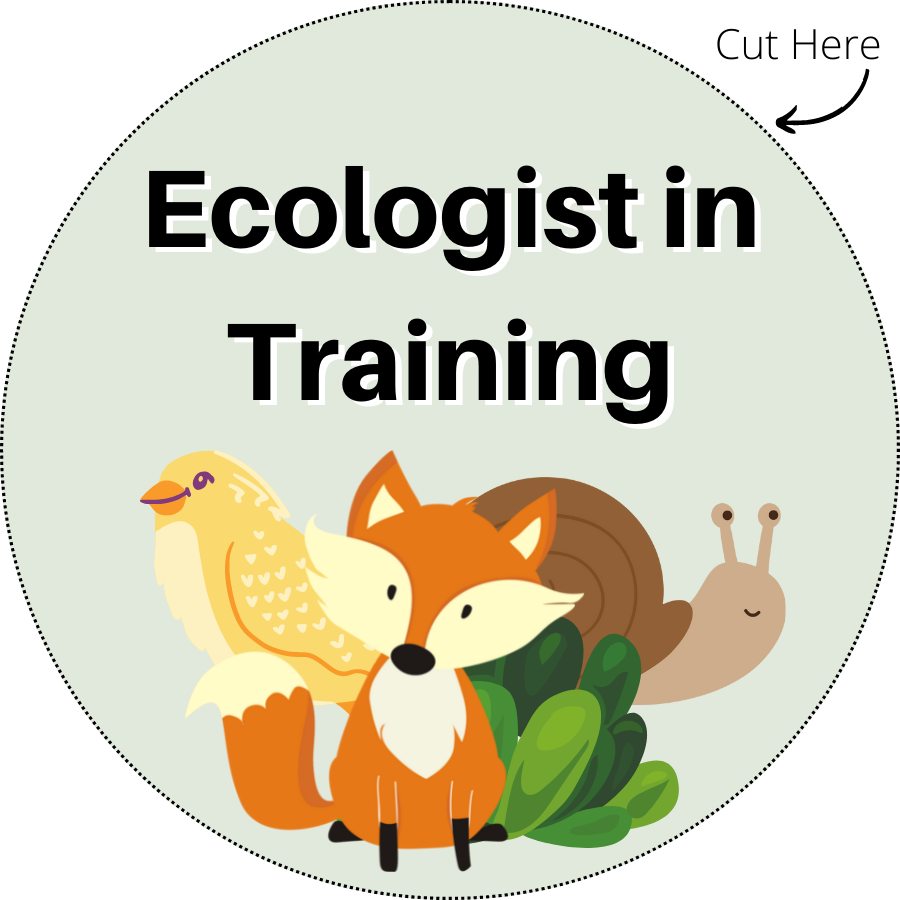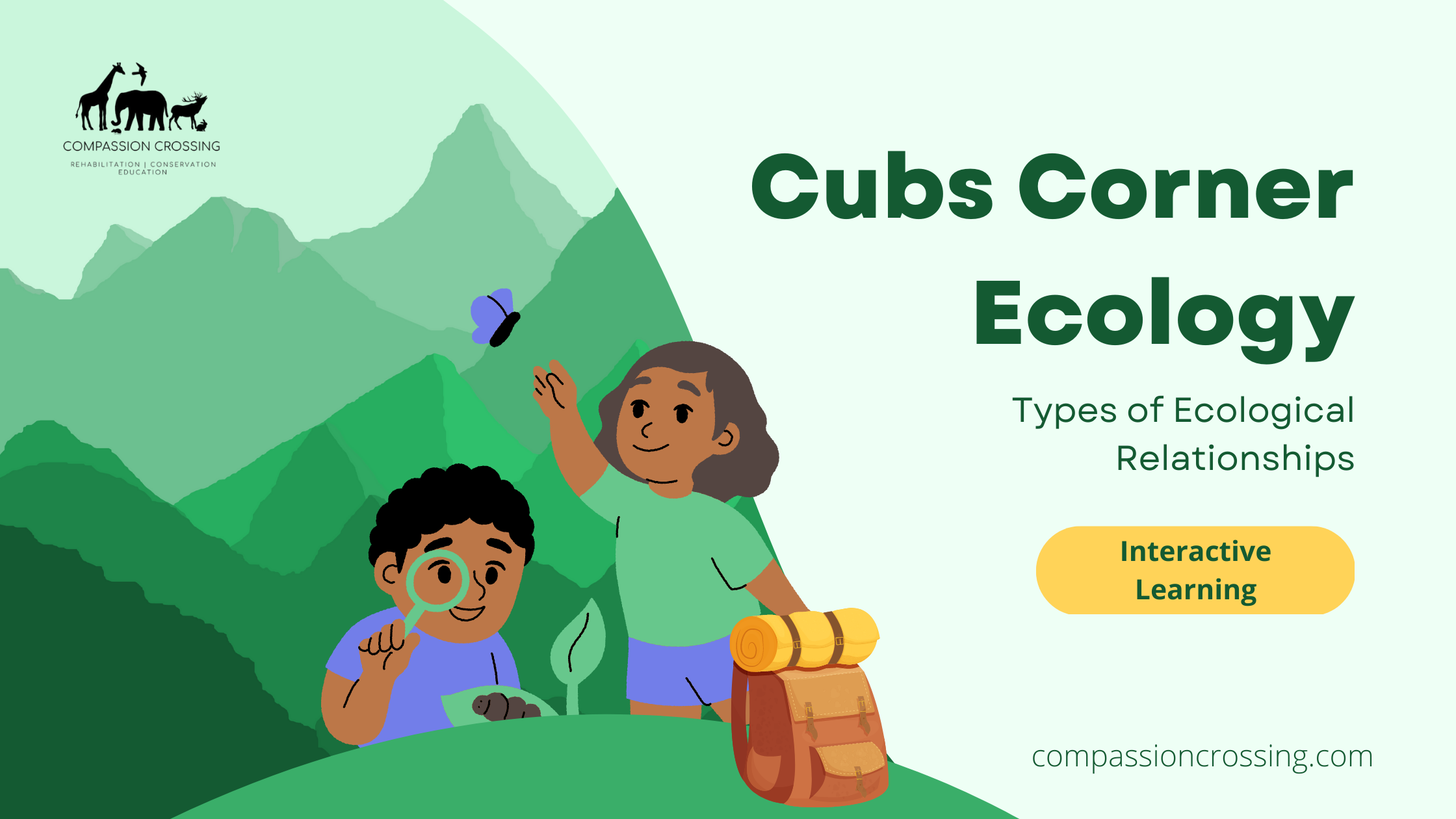Welcome to the world of ecology! The word ecology comes from the Greek term oikos, which means home. This field of science studies the interactions between living organisms in their environment (their home).
After each level, a badge is available for download. To have a personalized certificate created, send an email to compassioncrossing.contact@gmail.com with your name and photo (if you would like your personal image) or simply your name to have an organism filled in!
The entry badge for ecology is available without the completion of any activities!

Introduction to Ecology
Ecology is the scientific study of how living things interact with their environment. The environment includes all the living and nonliving things in an ecosystem, such as plants, animals, air, water, and soil. In ecology, scientists study how living things depend on each other and how they interact with their surroundings. Ecologists also study how human activities impact the environment and what we can do to protect it. Ecology is an important field because it helps us understand how the world around us works.
Review Questions:
- What is ecology?
- What does the environment include?
- Why is ecology an important field of study?
References:
- National Geographic Kids: Ecology
- Smithsonian Science Education Center: What is Ecology?
- Kids Discover: Ecology
Ecosystems
An ecosystem is a community of living and nonliving things that interact with each other. All the living things in an ecosystem depend on each other in some way. For example, plants need sunlight, water, and nutrients from the soil to grow. Animals eat plants or other animals for food. Decomposers, such as fungi and bacteria, break down dead plants and animals and return nutrients to the soil. All of these living things, along with nonliving things like air and water, make up an ecosystem.
Review Questions:
- What is an ecosystem?
- How do plants and animals depend on each other?
- What is the role of decomposers in an ecosystem?
References:
- National Geographic Kids: Ecosystems
- NOAA Office of Education: What is an Ecosystem?
- Kids Discover: Ecosystems
Ecological Relationships
Ecological relationships are the interactions that occur between living organisms and their environment. There are different types of ecological relationships, including mutualism, commensalism, parasitism, and predation. By understanding the different types of ecological relationships and their examples, we can appreciate the complex interactions that occur in nature.
Mutualism is a relationship between two species in which both benefit. An example of mutualism is the relationship between bees and flowers. Bees collect nectar from flowers to make honey, and while they are collecting nectar, they also help pollinate the flowers, allowing them to reproduce.
Commensalism is a relationship between two species in which one benefits, and the other is neither helped nor harmed. An example of commensalism is the relationship between cattle egrets and cattle. Cattle egrets feed on insects that are stirred up by cattle while they are grazing. The cattle are not affected by the presence of the egrets.
Parasitism is a relationship between two species in which one benefits, and the other is harmed. An example of parasitism is the relationship between a tick and a deer. The tick feeds on the blood of the deer, and in doing so, it weakens the deer and can transmit diseases.
Predation is a relationship between two species in which one species, the predator, kills and eats the other species, the prey. An example of predation is the relationship between a lion and a zebra. The lion hunts and kills the zebra for food.
Try the game below to test your knowledge of ecological relationships! (Hosted via Interacty)

Review Questions:
- What is mutualism, and what is an example of mutualism in nature?
- What is parasitism, and what is an example of parasitism in nature?
- What is predation, and what is an example of predation in nature?
References:
- Begon, M., Townsend, C. R., & Harper, J. L. (2006). Ecology: from individuals to ecosystems. Blackwell publishing.
- Odum, E. P. (1971). Fundamentals of ecology. Saunders.
- Ricklefs, R. E., & Miller, G. L. (2000). Ecology (4th ed.). W.H. Freeman and Company.
Let’s explore ecological interactions a litter further in these exercises! Each packet can be downloaded with the link provided after the images, below. Each exercise .pdf contains an answer key at the end of the packet!


Food Chains and Food Webs
A food chain shows how energy is transferred from one organism to another. In a food chain, the sun provides energy to plants, which are then eaten by herbivores. Herbivores are eaten by carnivores, and carnivores may be eaten by other carnivores. A food web is a more complex diagram that shows how many food chains are interconnected in an ecosystem. Every organism in a food web is important because it helps maintain the balance of the ecosystem.
Review Questions:
- What is a food chain?
- What is a food web?
- Why is every organism in a food web important?
References:
- National Geographic Kids: Food Chain
- NASA Climate Kids: Food Chains and Webs
- Kids Discover: Food Chains
Biodiversity
Biodiversity refers to the variety of living things in an ecosystem. Every organism in an ecosystem plays a role in maintaining its balance. When one species becomes extinct, it can disrupt the entire ecosystem. Humans can have a big impact on biodiversity by hunting animals, destroying habitats, and polluting the environment. We can help protect biodiversity by conserving natural habitats, reducing pollution, and not overfishing or hunting.
Review Questions:
- What is biodiversity?
- Why is every organism important in an ecosystem?
- How can humans help protect biodiversity?
References:
- National Geographic Kids: Biodiversity
- Smithsonian’s National Zoo & Conservation Biology Institute: Biodiversity
- Kids Discover: Biodiversity
Human Impact on the Environment
Humans can have a big impact on the environment. We can pollute the air and water, destroy habitats, and contribute to climate change. However, we can also make positive changes to protect the environment. We can recycle, reduce our use of single-use plastics, plant trees, and use clean energy sources like solar or wind power. By making small changes in our daily lives, we can all contribute to protecting the environment.
Review Questions:
- What is the impact of humans on the environment?
- What are some negative impacts humans have on the environment?
- How can we make positive changes to protect the environment?
References:
- National Geographic Kids: Human Impact on the Environment
- Environmental Protection Agency: Humans and the Environment
- Kids Discover: Human Impact on the Environment
Engaging Activity:
Create a “Green Challenge” chart with your classmates or family. Brainstorm different ways you can reduce your impact on the environment, such as turning off lights when you leave a room, bringing reusable bags to the grocery store, or picking up litter. Each time someone completes one of the challenges, they can mark it off on the chart. See who can complete the most challenges in a week or month!
Final Thoughts
Ecology is an important field that helps us understand how living things interact with their environment. In this module, we learned about ecosystems, food chains and webs, biodiversity, and human impact on the environment. By learning about ecology, we can make positive changes to protect the environment and the living things that depend on it.
Review Questions:
- What did we learn about in this module?
- Why is ecology an important field of study?
- What can we do to protect the environment?
References:
- National Geographic Kids: Ecology
- Smithsonian Science Education Center: What is Ecology?
- Kids Discover: Ecology
Answers to Review Questions
Introduction to Ecology
- What is ecology?
- Ecology is the scientific study of how living things interact with their environment.
- What does the environment include?
- The environment includes all the living and nonliving things in an ecosystem, such as plants, animals, air, water, and soil.
- Why is ecology an important field of study?
- Ecology is an important field of study because it helps us understand how the world around us works and how human activities impact the environment.
Ecosystems
- What is an ecosystem?
- An ecosystem is a community of living and nonliving things that interact with each other.
- How do plants and animals depend on each other?
- Plants provide food and oxygen for animals, while animals help pollinate plants and disperse their seeds.
- What is the role of decomposers in an ecosystem?
- Decomposers, such as fungi and bacteria, break down dead plants and animals and return nutrients to the soil.
Ecological Relationships
- What is mutualism, and what is an example of mutualism in nature?
- Mutualism is a relationship between two species in which both benefit. An example of mutualism is the relationship between bees and flowers. Bees collect nectar from flowers to make honey, and while they are collecting nectar, they also help pollinate the flowers, allowing them to reproduce.
- What is parasitism, and what is an example of parasitism in nature?
- Parasitism is a relationship between two species in which one benefits, and the other is harmed. An example of parasitism is the relationship between a tick and a deer. The tick feeds on the blood of the deer, and in doing so, it weakens the deer and can transmit diseases.
- What is predation, and what is an example of predation in nature?
- Predation is a relationship between two species in which one species, the predator, kills and eats the other species, the prey. An example of predation is the relationship between a lion and a zebra. The lion hunts and kills the zebra for food.
Food Chains and Food Webs
- What is a food chain?
- A food chain shows how energy is transferred from one organism to another.
- What is a food web?
- A food web is a more complex diagram that shows how many food chains are interconnected in an ecosystem.
- Why is every organism in a food web important?
- Every organism in a food web is important because it helps maintain the balance of the ecosystem.
Biodiversity
- What is biodiversity?
- Biodiversity refers to the variety of living things in an ecosystem.
- Why is every organism important in an ecosystem?
- Every organism in an ecosystem plays a role in maintaining its balance, and when one species becomes extinct, it can disrupt the entire ecosystem.
- How can humans help protect biodiversity?
- Humans can help protect biodiversity by conserving natural habitats, reducing pollution, and not overfishing or hunting.
Human Impact on the Environment
- What is the impact of humans on the environment?
- Humans can have a big impact on the environment, including pollution, habitat destruction, and contributing to climate change.
- What are some negative impacts humans have on the environment?
- Some negative impacts humans have on the environment include air and water pollution, deforestation, and overfishing.
- How can we make positive changes to protect the environment?
- We can make positive changes to protect the environment by recycling, reducing our use of single-use plastics, planting trees, and using clean energy sources like solar or wind power.
Final Thoughts
- What did we learn about in this module?
- In this module, we learned about ecology, ecosystems, food chains and webs, biodiversity, and human impact on the environment.
- Why is ecology an important field of study?
- Ecology is an important field of study because it helps us understand how living things interact with their environment and how human activities impact the environment.
- What can we do to protect the environment?
- We can protect the environment by making positive changes in our daily lives, such as recycling, reducing our use of single-use plastics, planting trees, and using clean energy sources like solar or wind power.